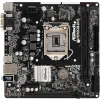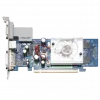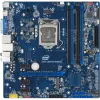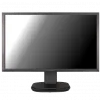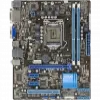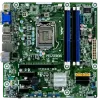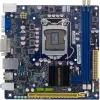The Digital Visual Interface (DVI) is a video interface standard designed to provide very high visual quality on digital display devices such as flat panel LCD computer displays and digital projectors. It was developed by an industry consortium, the Digital Display Working Group (DDWG) to replace the "legacy analog technology" VGA connector standard. It is designed for carrying uncompressed digital video data to a display. It is partially compatible with the High-Definition Multimedia Interface (HDMI) standard in digital mode (DVI-D), and VGA in analog mode (DVI-A).
The DVI interface uses a digital protocol in which the desired illumination of pixels is transmitted as binary data. When the display is driven at its native resolution, it will read each number and apply that brightness to the appropriate pixel. In this way, each pixel in the output buffer of the source device corresponds directly to one pixel in the display device, whereas with an analog signal the appearance of each pixel may be affected by its adjacent pixels as well as by electrical noise and other forms of analog distortion.
DVI is mostly compatible with HDMI. The main difference is that DVI typically carries no audio data in its TMDS channel, although increasingly, modern PC video hardware is providing audio (e.g., cards by NVIDIA and ATI), allowing the PC to send audiovisual data to a high definition television with an HDMI input. If a PC's DVI output does not provide audio, it can be patched in as part of the DVI to HDMI adapter.
The data format used by DVI is based on the PanelLink serial format devised by the semiconductor manufacturer Silicon Image Inc. This uses transition minimized differential signaling (TMDS). A single DVI link consists of four twisted pairs of wires (red, green, blue, and clock) to transmit 24 bits per pixel. The timing of the signal almost exactly matches that of an analog video signal. The picture is transmitted line by line with blanking intervals between each line and each frame, and without packetisation. No compression is used and there is no support for only transmitting changed parts of the image. This means that the whole frame is constantly re-transmitted. The specification (see below for link) does, however, include a paragraph on "Conversion to Selective Refresh" (under 1.2.2), suggesting this feature for future devices.
With a single DVI link, the largest resolution possible at 60 Hz is 2.75 megapixels (including blanking interval). For practical purposes, this allows a maximum screen resolution at 60 Hz of 1,915 × 1,436 pixels (standard 4:3 ratio), 1,854 × 1,483 pixels (5:4 ratio), or 2,098 × 1,311 (widescreen 16:10 ratio). The DVI connector therefore has provision for a second link, containing another set of red, green, and blue twisted pairs. When more bandwidth is required than is possible with a single link, the second link is enabled, and alternate pixels may be transmitted on each, allowing resolutions up to 4 megapixels at 60 Hz. The DVI specification mandates a fixed single link maximum pixel clock frequency of 165 MHz, where all display modes that require less than this must use single link mode, and all those that require more must switch to dual link mode. When both links are in use, the pixel rate on each may exceed 165 MHz. The second link can also be used when more than 24 bits per pixel is required, in which case it carries the least significant bits. The data pairs carry binary data at ten times the pixel clock reference frequency, for a maximum data rate of 1.65 Gbit/s × 3 data pairs for a single DVI link.
Like modern analog VGA connectors, the DVI connector includes pins for the display data channel (DDC). DDC2 (a newer version of DDC) allows the graphics adapter to read the monitor's extended display identification data (EDID). If a display supports both analog and digital signals in one input, each input can host a distinct EDID. If both receivers are active, analog EDID is used.
The maximum length of DVI cables is not included in the specification since it is dependent on bandwidth requirements (the resolution of the image being transmitted). In general, cable lengths up to 4.5 m (15 ft) will work for displays at resolutions of 1,920 × 1,200. This resolution will work even up to 10 m (33 ft) if a special cable is used. Cable lengths up to 15 m (50 ft) can be used with displays at resolutions up to 1,280 × 1,024. For longer distances, the use of a DVI booster is recommended to mitigate signal degradation. DVI boosters may use an external power supply.
The DVI connector usually contains pins to pass the DVI-native digital video signals. In the case of dual-link systems, additional pins are provided for the second set of data signals.
Dual-link should not be confused with dual display (also called dual head), which describes those situations where a computer is hooked up to two monitors at once. Either, one, or both of the dual displays could be dual-link. Depending on the video card(s), the displays could be both analog (VGA), an analog and a digital, or both digital.
As well as digital signals, the DVI connector includes pins providing the same analog signals found on a VGA connector, allowing a VGA monitor to be connected with a simple plug adapter (or with a special purpose VGA to DVI-A or DVI-I cable). This feature was included in order to make DVI universal, as it allows either type of monitor (analog or digital) to be operated from the same connector.
The DVI connector on a device is therefore given one of four names, depending on which signals it implements:
- DVI-D (digital only)
- DVI-A (analog only)
- DVI-I (integrated, digital, and analog)
- M1-DA (integrated, digital, analog, and USB)
The connector also includes provision for a second data link for high resolution displays, though many devices do not implement this. In those that do, the connector is sometimes referred to as DVI-DL (dual link).
The long flat pin on a DVI-I connector is wider than the same pin on a DVI-D connector, so it is not possible to connect a male DVI-I to a female DVI-D by removing the 4 analog pins. It is possible, however, to connect a male DVI-D cable to a female DVI-I connector. Many flat panel LCD monitors have only the DVI-D connection so that a DVI-D male to DVI-D male cable will suffice when connecting the monitor to a computer's DVI-I female connector.
DVI is the only widespread video standard that includes analog and digital transmission options in the same connector. Competing standards are exclusively digital: these include a system using low-voltage differential signaling (LVDS), known by its proprietary names FPD-Link (flat-panel display) and FLATLINK; and its successors, the LVDS Display Interface (LDI) and OpenLDI.
Some new DVD players, TV sets (including HDTV sets) and video projectors have DVI/HDCP connectors; these are physically the same as DVI connectors but transmit an encrypted signal using the HDCP protocol for copy protection. Computers with DVI video connectors can use many DVI-equipped HDTV sets as a display; however, due to Digital Rights Management, it is not clear whether such systems will eventually be able to play protected content, as the link is not encrypted.
USB signals are not incorporated into the connector, but were earlier incorporated into the VESA Plug and Display connector used by InFocus on their projector systems, and in the Apple Display Connector, which was used by Apple until 2005.
The DMS-59 connector is a way to combine two analog and two digital signals in one plug. It is commonly used when a single graphics card has two outputs.
M1-DA connectors are sometimes labeled as DVI-M1; they are used for the VESA Enhanced Video Connector and VESA Plug and Display schemes.
Digital
- Minimum clock frequency: 25.175 MHz
- Maximum clock by cable quality (up to 330 Mhz, 7.92 Gbit/s)
- Pixels per clock cycle: 1 (single link) or 2 (dual link)
- Bits per pixel: 24 (single and dual link) or 48 (dual link only)
- Example display modes (single link):
- HDTV (1,920 × 1,080) @ 60 Hz with CVT-RB blanking (139 MHz)
- UXGA (1,600 × 1,200) @ 60 Hz with GTF blanking (161 MHz)
- WUXGA (1,920 × 1,200) @ 60 Hz with CVT-RB blanking (154 MHz)
- SXGA (1,280 × 1,024) @ 85 Hz with GTF blanking (159 MHz)
- WXGA+ (1440 × 900) @ 60 Hz (107 MHz)
- WQUXGA (3,840 × 2,400) @ 17 Hz (164 MHz)
- Example display modes (dual link):
- QXGA (2,048 × 1,536) @ 75 Hz with GTF blanking (2 × 170 MHz)
- HDTV (1,920 × 1,080) @ 85 Hz with GTF blanking (2 × 126 MHz)
- WUXGA (1,920 × 1,200) @ 120 Hz with GTF (2 x 154 MHz)
- WQXGA (2,560 × 1,600) @ 60 Hz with GTF blanking (2 × 174 MHz) (30-inch (762 mm) Apple, Dell, Gateway, HP, NEC, Quinux, and Samsung LCDs)
- WQXGA (2,560 × 1,600) @ 60 Hz with CVT-RB blanking (2 × 135 MHz) (30-inch (762 mm) Apple, Dell, Gateway, HP, NEC, Quinux, and Samsung LCDs)
- WQUXGA (3,840 × 2,400) @ 33 Hz with GTF blanking (2 × 159 MHz)
GTF (Generalized Timing Formula) is a VESA standard which can easily be calculated with the Linux gtf utility.
CVT-RB (Coordinated Video Timings-Reduced Blanking) is a VESA standard which offers reduced horizontal and vertical blanking for non-CRT based displays.
Clock and data relationship
The DVI data channel operates at a bit-rate multiple of 10 times the frequency of the clock signal. In other words, for every DVI clock there are 10 bits provided on each of the three data channels. The data is encoded using a standard 8b/10b encoding to provide a minimum transition density in which there are no more than five consecutive bits of the same value, which is necessary to provide reference edges for clock/data recovery circuits. As indicated in version 1.0 of the specification, the clock rate is the same as the pixel rate plus framing overhead, while there are usually 24 bits per pixel.
Since the data is switching at 10 times the clock rate, a receiver must recover the faster bit clock from the data lines itself (using a PLL or DLL, for instance) in a process known as clock/data recovery. The DVI clock is effectively a 1⁄10th frequency reference clock that is useful for the clock/data recovery circuitry to synchronize to the bitstream. DVI provides a reference clock while other serial data interfaces such as PCI Express and SATA do not because the bit rate carried by the DVI interface may vary across a wide frequency range depending on the video format being rendered. Serial interfaces that do not explicitly carry the reference clock are typically defined to run at a specific known frequency or several derivative frequencies that are related by whole number multiples (for example 2.5 Gbit/s and 5.0 Gbit/s for successive generations of PCI Express and 1.5 Gbit/s and 3.0 Gbit/s for successive generations of SATA), so in these cases a fixed frequency reference clock can be generated locally at the receiver that performs the clock/data recovery.
Display Power Management
The DVI specification includes signaling for Display Power Management. Similar to the analog VESA Display Power Management Signaling, a connected device can turn a monitor off when powering down. Devices with this capability can also earn Energy Star certification.
Analog
- RGB bandwidth: 400 MHz at −3 dB
